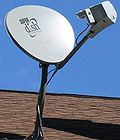Microwave
A microwave is a high-frequency radio wave. They are broadly defined as having a wavelength between 1 millimeter and 1 meter, or narrowly between 3 mm and 300 mm. Microwaves have many uses including radar, radio astronomy, and to heat food in a microwave oven. Unlike longer radio waves, they do not bend around land obstacles but go in line of sight. Still, they are much used for communication because they can have a high bandwidth. Almost all spacecraft communicate by microwave radio.[1][2]
When something moves, it almost always has a wave pattern to its movement - this can be seen in water most easily, in ripples and ocean waves. A very common type of wave in the universe is electromagnetic waves. Light is an example of an electromagnetic wave, and so is a microwave, for example the cosmic microwave background radiation. We can only see electromagnetic radiation in the visible light spectrum (which is why it's called the visible light spectrum), so microwaves are invisible.[3]
Microwaves were among the first radio waves discovered, in the late 19th century, by Heinrich Rudolf Hertz.[2]
Microwave Ovens
Microwave ovens work because microwaves make polar molecules (molecules that act like massive magnets) all face the same direction - to visualize it, imagine that the microwave oven is telling all of the molecules to face left, then right. Heat is just the movement of molecules, so when the molecules do a great amount of moving, they are hot.
Like other heat sources, microwave radiation can cause burns. They can go through skin and muscles. If vital organs are burned, the burns can kill. This is why a microwave oven does not work with the door open.
Microwave Media
A telecommunications tower with a variety of dish antennas for microwave relay links on Frazier Peak, Ventura County, California. The apertures of the dishes are covered by plastic sheets (radomes) to keep out moisture.
The atmospheric attenuation of microwaves and far infrared radiation in dry air with a precipitable water vapor level of 0.001 mm. The downward spikes in the graph correspond to frequencies at which microwaves are absorbed more strongly. This graph includes a range of frequencies from 0 to 1 THz; the microwaves are the subset in the range between 0.3 and 300 gigahertz.
Waveguide is used to carry microwaves. Example of waveguides and a diplexer in an air traffic control radar.
Disassembled radar speed gun. The grey assembly attached to the end of the copper-colored horn antenna is the Gunn diode which generates the microwaves.
A satellite dish on a residence, which receives satellite television over a Ku band 12–14 GHz microwave beam from a direct broadcast communications satellite in a geostationary orbit 35,700 kilometres (22,000 miles) above the Earth
The parabolic antenna (lower curved surface) of an ASR-9 airport surveillance radar which radiates a narrow vertical fan-shaped beam of 2.7–2.9 GHz (S band) microwaves to locate aircraft in the airspace surrounding an airport
Small microwave oven on a kitchen counter
Absorption wavemeter for measuring in the Ku band
ku band microstrip circuit used in satellite television dish
References
- ↑ "Microwave Technology". CableFree. Retrieved 2021-06-16.
- ↑ 2.0 2.1 "Microwave radio | computer science". Encyclopedia Britannica. Retrieved 2021-06-16.
- ↑ "Microwave Communication: Using a Microwave Link". www.dpstele.com. Retrieved 2021-06-16.









